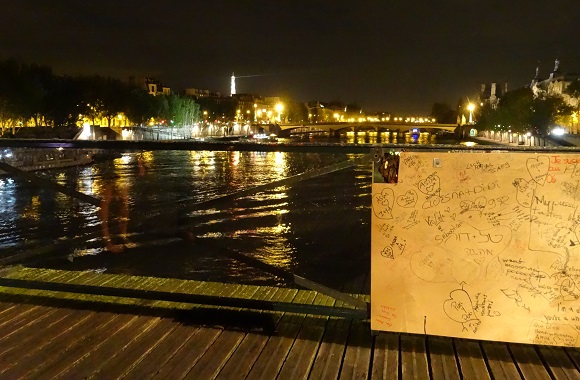
The City of Paris has begun investing in the fight against love locks on its famous bridges by placing glass panels that bring back the stunning views that attracted people to place locks there in the first place.
* * *
There is general agreement among residents of Paris that love locks are a form of graffiti that defaces the beauty it is intended to glorify. It’s a form of graffiti that nevertheless attracts, fascinates and generally pleases visitors. Many a museum director would love to have their collections as well known to tourists as the collection of metal on what are now referred to as Lock Bridges.
For the administration of the City of Paris, love locks don’t raise esthetic questions as much as cost and security questions since the weighty accumulation of locks on the bridges of Paris damages the host structures and creates safety issues. According to City Hall, over the past few months alone more than 700,000 locks have been placed on Paris’s various lockable bridges, i.e. those with metal grating that serves as the base for the lock virus. Luckily, most of Paris’s central bridges have stone railings.

On the Pont des Arts, the most famous of the lock bridges, a pedestrian bridge with an extraordinary view connecting the Right Bank at the Louvre with the Left Bank at the French Institute, 15 grating panels have already had to be removed for security reasons. The weight of 1100 pounds (500 kg) of locks on a single panel is four times the allowable weight limit for a portion of the railing.
Required to act, the City of Paris yesterday began experimenting with glass panels to replace some of the metal grating. Two have been placed on the Pont des Arts and others will follow.
“Paris is the capital of love, we’re very proud of that, but there are more beautiful ways to show that love then placing locks on a bridge,” said Bruno Julliard, deputy mayor and the official appointed to find what City Hall calls “artistic and ecological alternative solutions.”
The new glass panels are light enough to be supported by the bridge, and their transparency allows for a renewed view of the scenery that attracted people to place locks here in the first place.

It’s a clear reminder of how destructive and unappealing the lock virus has become over the years. Whether the glass panels can be spared more usual forms of graffiti remains to be seen.
“If this experiment proves to be conclusive we’ll extended it to other affected bridges,” said Julliard.
Since August, the City of Paris has also been inviting visitors to show and seal their union with a selfie rather than a lock through #LoveWithoutLocks in the hopes of making them aware of less destructive ways of demonstrating the affiliation between Paris and romance. A long kiss by the river might to do the trick as well.
– September 20, 2014
For a sweeter view of love locks, see this France Revisited video from 2012.

